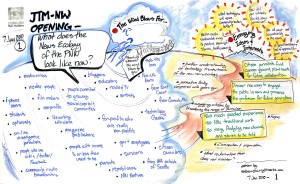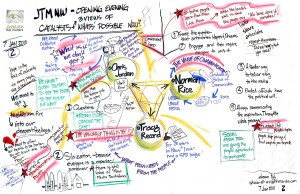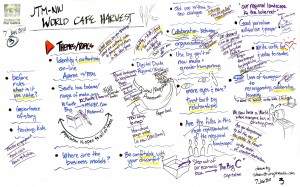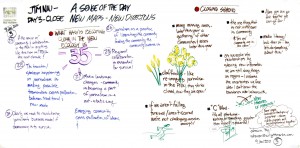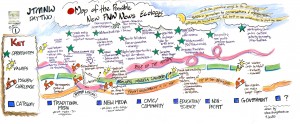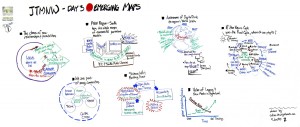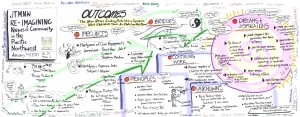Submitted by kegill on Thu, 01/07/2010 – 10:42am
Session Reporter: Kathy & Brian
Conversationalist 1: Kathy Gill
Conversationalist 2: Brian Glanz
Brian and Kathy did an email exchange. 🙂
1. Tell me about your work and how it led to saying “yes” to this confab…
Kathy: I’ve been involved in the ‘future of news’ conversations in the PNW for the past year. I am interested in this event because of its potential to expand the discussion beyond the usual suspects. I am also interested in observing people who are attending their first ‘unconference’ — I’m interested in the dynamics of spontaneous organization.
Brian: JIMMY STEWART IMPRESSION: This isn’t fair at all, I’ve got to follow @kegill and all I’ll have to say is “I agree.”
I have haunted the No News is Bad News and similar events for a while now, myself and I do agree, new input will be welcome. I also lead a small organization looking to contribute technology to our “news ecology” particularly in social networking and citizen journalism. You can see what we’re bringing to JTM at http://opensciencefederation.com/ We’ve put together a special version just to give it a go, here.
2. It’s clear the relationship between journalists and the public is changing…
Kathy: Here’s a tweet I sent today:
Crowdsourcing media reports on Xmas Bomber “intelligence failure” – TPM http://bit.ly/5ZLW5h via @DanGillmor
TalkingPointsMemo has a track record of reaching out to its community for help — and the community responds because there is a relationship. Monica Guzman and Linda Thomas are examples of local journalists who also connect with the community with Twitter. So is Tracy Record.
The journalist-as-aloof-and-above-the-crowd-professional model is broken. Not a bad thing, IMO.
Brian: As a career software and web site guy, I’ve been mildly entertained by journalists begging bloggers for tips, after years of we all know what. I would call that a positive difference in a story that matters.
I also ghost write and edit for a few local, first amateur and now professional food bloggers. The discomfort with which the old fashioned publishing and food writing crowd has had to embrace and keep pace with food bloggers has been similarly entertaining.
3. What is essential to the relationship between journalism and the public for getting information and opinion for good civic choices? …
Kathy: TRUST and conversation = engagement/involvement
That’s the opposite of today’s detached, non-civicly-involved citizen
Brian: I will go with openness. Open can mean transparency, that the public wants in government and in corporations so journalism can peer in, that the public also wants in corporate journalism so we can peer in. Open can mean access, so we can interact with journalists and contribute to journalism.
It’s at least as essential that the American public come to terms with how important journalism is and that we take greater responsibility for it. If journalism were willing to give up fortune and glory, America might be willing to fund our own BBC/CBC/… In the interest of time I will stop this answer while still on the first part of the first question, “What is essential to the relationship…”
4. Without being humble, what do you value most about yourself? What do you see yourself bringing to this confab?
Kathy: I bring a passion for ‘news’ and an understanding of the systemic changes we are living through. (I argue that the changes are not sudden or new – they are a logical evolution of those that began with the advent of the telegraph.) I’m a good writer – synthesizer.
Brian: I know a lot about what is possible technologically, and big J Journalism and a lot of mainstream media are still technologically undergunned.
I hit CNN.com recently and was overwhelmed by how much their latest redesign looks like a WordPress based web site I finished in December, for release by a client of mine early this year. There are more than 200 million sites using WordPress, and my version is a one-man, 20-hour design and development job; CNN should be doing better. Risks include that the public will take professional journalists even less seriously as they ape our blogs.
I noticed MSNBC picked up breakingnews.com and I appreciate the buzz around “the real-time web,” but one way in which the pros must improve is by doing what most amateurs cannot — investigative, serious and slow news and gorgeous, top shelf content. Breaking news isn’t going anywhere of course, they call it “news” not “olds,” but I don’t think I’m alone in wanting less shouting, fewer errors, less parroting of sources and more reporting. Google who brought us the most real-time bit yet, Wave have also brought us Living Stories. Slow is not necessarily low tech, or old fashioned in a bad way.
Telling more poignant, fuller stories, hosting longer term conversations, and the big J back in journalism — as a consumer, I want the pros to stop aping amateurs, I want them to be pros. I hope JTM plugs me in or points me where I can help.
5. The year is 2015 and the Pacific Northwest has a vibrant media landscape…
Kathy: Our media landscape in 2015 will hopefully be a rich mix of hyperlocal websites that are thriving (ie, making money), more traditional news sources and emerging alternative journalism models. I don’t think there will be three thriving local TV stations; the Seattle Times will not be publishing a printed newspaper daily (once or twice a week, probably).
We need ubiquitous and free or really-cheap wifi and wider adoption of handheld devices (smartphones, PDAs, tablets) plus literacy efforts. I worry about the digital divide in all its forms. The conference could help launch awareness of the infrastructure needed to support connectedness.
A major goal of the event has to be awareness-raising of the complex system in which journalism and democracy co-exist.
Brian: Thinking five years ahead makes me want to look five years back. Scott McNealy was informing us that The Participation Age had dawned, and I was into Tablet PCs. I suppose some of what we’re trying hard to realize now will still just be blooming five years on. It might take that long before we’re actually doing “the real-time web” the way it’s being talked about now, for example.
Will greater immediacy of communication and transparency in our lives lead to greater honesty or more complicated deception? I guess more the former, some of both.
Because so much of journalism is a business, the profit motive will lead to attempted reinforcement of the deteriorating distinction between journalists and the public. A flat media world does not a good media business make. Resource battles over press passes and access in all limited forms will be fought with as much money as angst. As we all know more about the details of our politicians’ daily lives for example, we will question more how they spend them.
Navigating the next five years requires exactly what we’re doing, intentional and productive engagement. With the right work leading up to it, maybe in five years, half of a commercial, local, video news program is comprised of “viewer” contributions. Every once in a while we see a viewer-contributed photo on the TV news; expect that to be every day, and more of the news, in five years. Real and candid, a little corny and definitely entertaining, maybe we’ll call it “reality news.” New technology like high quality mobile video, faster networks, and wireless power could break it open. The key is for media professionals to not only be reacting to a threatening technological upswell, but to be clued in early and invested so we all gain from the possibilities.

